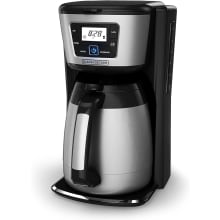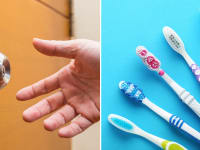Your coffee maker is probably full of mold—here's how to clean it
You're going to want to do this immediately.
Products are chosen independently by our editors. Purchases made through our links may earn us a commission.
We all have our own tastes when it comes to how we take our coffee. Do you like it black? With a splash of almond milk and some stevia? With as much cream and sugar as possible?
What about with a healthy helping of bacteria?
That could be the disgusting truth if you make your coffee at home—and haven't cleaned your coffee maker in months (guilty!). According to a recent study by the National Science Foundation, your coffee maker is probably grosser—and moldier—than you think. Here's exactly what researchers found lurking in our coffee makers and how to keep them clean.
How gross your coffee maker really is
The study revealed that 50 percent of American households had yeast and mold growing in the reservoir of their coffee makers. And about one in 10 coffee makers had traces of coliform, a bacteria that's found in animal and human feces and can cause diseases (yikes!).
Keep in mind that even if you can't see any visible mold, it could be hiding inside your coffee maker, particularly in the water reservoir. "Coffee makers are an ideal environment for bacteria and mold to grow in high volumes," our kitchen and cooking writer, Valerie Li, explains as mold thrives in dark, moist areas.
How often you should clean your coffee maker
It depends on how often you use your coffee maker (a.k.a if you brew a pot every day, you'll need to clean it more often than someone who only uses it a few times a month). Our kitchen and cooking writer, Valerie Li, recommends deep cleaning your coffee maker about once every two weeks if you're a daily brewer.
That being said, a daily quick clean can go a long way in preventing mold growth, too. "I would suggest rinsing the water reservoir part of the coffee maker and the carafe on a daily basis," Li says.
How to clean your coffee maker
According to Li, the best way to clean your coffee maker is with white vinegar via a process known as decalcifying. "Decalcifying is similar to descaling," she explains. "You fill the water tank with water and white vinegar (the ratio is 1:1) and let it brew until the carafe is half filled. Then rinse out any remaining vinegar/water residue."
If you have a Keurig (or another single-serve coffee maker), you can use a similar technique. Pour the vinegar and water into the water reservoir, brew a cup as you usually would—without a pod, of course—then wait 30 minutes before running plain water through the machine.
And for anyone who suspects their coffee maker is particularly disgusting (like if you've never cleaned it), you can up the 1:1 ratio to 2 parts white vinegar to one part water. You can also repeat the entire process as many times as you'd like for the most thorough cleaning.

For the price, you'll get a coffee maker that brews consistently smooth and flavorful coffee.

This coffee maker packs a few gadgets into one—it can make cold brew, iced coffee, and even pour-over using an adapter.


